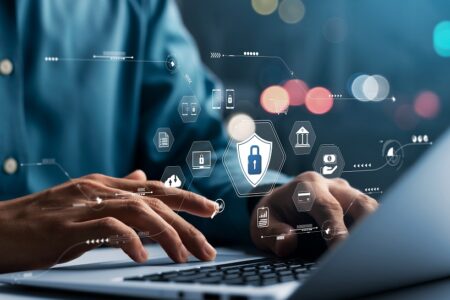27 November 2024
By Roger Kennedy
roger@TheCork.ie

Cyber security and digital marketing in 2025 will converge, addressing AI-driven threats, data privacy, and innovative marketing strategies. Explore trends and insights.
The Future of Cybersecurity and Marketing
Imagine this: by 2025, the line between digital marketing and cybersecurity will blur even more. As AI-driven tools reshape marketing strategies, they also open doors for cyber threats. Did you know that 95% of cyber incidents are linked to web browsers? Companies increasingly rely on secure enterprise browsers to protect their employees and data while managing their online marketing campaigns effectively.
Let’s explore how cybersecurity trends will influence digital marketing strategies and vice versa in 2025.
Cybersecurity: A Growing Concern
The rise of 5G, IoT, and AI brings unmatched opportunities but also heightened vulnerabilities. For marketers, this means securing customer data is non-negotiable. Quantum computing, poised to disrupt traditional encryption, challenges how we safeguard sensitive information. Adopting quantum-safe protocols will be critical for both IT teams and marketers handling large-scale campaigns.
But it’s not just about encryption. AI is now a double-edged sword. While it helps marketers predict trends and personalize campaigns, cybercriminals use it to craft sophisticated phishing attacks. Investing in AI-driven threat detection tools will become a standard practice by 2025.
Data Privacy and Customer Trust
With the expansion of privacy laws worldwide, marketers must prioritize compliance to maintain customer trust. In Europe, the AI Act builds on GDPR, tightening controls over cross-border data transfers. Similarly, global markets like Brazil and the Middle East are enhancing their cybersecurity frameworks.
For marketers, this means more than ticking boxes. It’s about embedding privacy in every step of a campaign, from ideation to execution. And let’s not forget, secure platforms are critical. Embedding tools like enterprise browsers can ensure safe digital interactions, reducing the risks of compromised customer trust.
For more insights on secure tools like an android spy app to safeguard data while managing digital assets, explore advanced solutions designed to keep your campaigns secure.
AI in Marketing: Friend or Foe?
AI-powered tools are revolutionizing how brands connect with audiences. From chatbots to predictive analytics, marketers are crafting hyper-personalized experiences. Yet, this reliance on AI introduces new risks.
For instance, deepfakes can be weaponized to harm a brand’s reputation. Marketers and cybersecurity teams must collaborate to identify fake content and ensure authenticity. Similarly, marketing teams using AI for email outreach must guard against AI-generated phishing campaigns that mimic their tone and style.
Digital Identity: A Critical Asset
One emerging trend is the safeguarding of digital identities. As campaigns leverage more personal data, the risk of identity theft grows. A stolen identity can compromise both consumers and businesses. To counter this, 2025 will see widespread adoption of advanced verification technologies and stricter access controls.
Organizations should also consider adopting zero-trust architecture—a “never trust, always verify” approach. This paradigm shift ensures that no action or user gets unrestricted access, reducing vulnerabilities for marketing operations and customer databases alike.
Bridging Cybersecurity and Marketing
So, how do these trends converge? A secure digital environment is the foundation of any successful marketing campaign. Businesses that prioritize cybersecurity not only protect their operations but also build stronger, more trustworthy relationships with their audiences.
Take, for example, the importance of endpoint protection. With employees working on personal devices, secure enterprise browsers allow marketers to safely access business applications and manage sensitive campaigns without risking data breaches. This seamless yet secure setup will become the gold standard for 2025.
Takeaways for 2025
As we gear up for 2025, here’s what you should focus on:
- Invest in AI Defense: Use advanced AI tools not only for marketing but also to detect and prevent cyber threats.
- Enhance Privacy Protocols: Stay ahead of evolving data privacy regulations by embedding security in your marketing processes.
- Adopt Zero-Trust Models: Limit access to sensitive data and applications through robust verification systems.
- Leverage Secure Tools: From enterprise browsers to secure cloud platforms, prioritize tools that protect your data and campaigns.
Final Thoughts
By aligning cybersecurity strategies with marketing innovation, businesses can thrive in an interconnected, digital-first world. After all, protecting your brand is as important as promoting it.
In 2025, the convergence of cybersecurity and digital marketing will redefine how businesses operate in the digital landscape. As technology evolves, so do threats, making cybersecurity an indispensable aspect of marketing strategies. Protecting consumer trust through robust data privacy practices and advanced security tools will no longer be optional—it will be a competitive advantage.
AI, though a game-changer in personalizing campaigns, will demand vigilance as it becomes a tool for both innovation and exploitation. Addressing risks like deepfakes and AI-driven phishing will require collaboration between marketing and IT teams, ensuring campaigns remain authentic and secure. Similarly, adopting zero-trust models and secure enterprise browsers will empower organizations to protect sensitive data without compromising efficiency.
Ultimately, businesses that seamlessly integrate cybersecurity into their marketing efforts will stand out. They’ll not only safeguard their operations but also foster deeper trust with their audiences. By staying ahead of emerging threats and leveraging cutting-edge solutions, organizations can thrive in this complex digital era.
The future of digital marketing isn’t just about creativity—it’s about security. Are you ready to embrace this new frontier?

